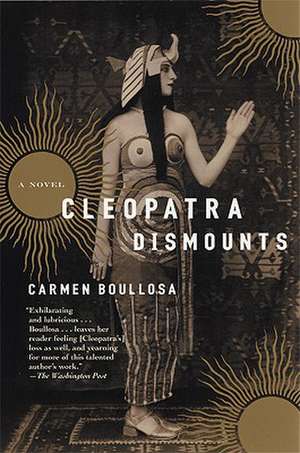Cleopatra Dismounts
Autor Carmen Boullosa Traducere de Geoff Hargreavesen Limba Engleză Paperback – 30 sep 2004
Carmen Boullosa’s Cleopatra Dismounts tells three versions of the life of Cleopatra. In the first sequence, Marc Antony had just disemboweled himself, knowing they had lost the war against Octavian and believing that Cleopatra was dead. Hugging his corpse, Cleopatra castigates Octavian and history for its betrayal of her, recalling variously how she had herself delivered to Caesar in a roll of carpet, and bore his child (Caesarion); the twins and third child she bore to Marc Antony; the bitterness of the recent military defeat.
At this point Diomedes, variously described as an informer and her official chronicler, intercedes, admitting that this version of the story is not true to the brilliant, accomplished woman who was the true Cleopatra really was. Telling of how he betrayed Cleopatra, by altering the histories of her reign and allowing Caesar and others to destroy or change her scrolls, he begins again with the story of Cleopatra’s flight from Pompey (the Roman leader who was placed in charge of Cleopatra and her brothers and sisters after Ptolemy Auletes, her father and ruler of Egypt, died). The girl queen (Cleopatra inherited the throne as a teenager) sneaks with several faithful servants out of the palace into a wagon, accompanied by a group of brightly costumed gladiators, on her way to Ascalon. She and her supporters carve the words “Queen of Kings” (Cleopatra’s motto in real history) into the boards of the wagon in which she is traveling, and leave it behind when they reach Rome. When they are beset by pirates, Cleopatra stages an elaborate show using some costumes the young gladiator Apollodorus, who has become part of her retinue, helped her buy. She convinces the pirates that she is Isis (a myth which was in reality part of her statecraft). She makes an alliance with them and is taken in peace to Cilicia.
The third and longest version of the Cleopatra story is a delightful interlude in which Cleopatra goes live with the Amazons. Cleopatra is at war with the Ruling Council of her husband and brother Ptolemy (she was, historically, forced to marry her brother because she could not rule alone as a woman). The Ruling Council has sent an envoy to summon her to Alexandria to make peace, but when she realizes it is a trap, she flees with her retinue. She arrives in Pelusium, a trade center on the Mediterranean, where many merchants have been stranded by bad weather, and where, as if by magic, she sees a replica of the cart, carved with the words “Queen of Kings,” she left behind in Rome. Chased by the “reception committee” of the Ruling Council, she escapes on the back of a magical bull. He carries her across the Mediterranean to the land of the Amazons, who take her in. The Amazons welcome her into their society of women, eschewing marriage and traditional female roles to live as warriors and hunters. They sing her the stories of their joining the Amazons and of the many myths that surround them. She meets a group of aged poets, kidnapped by the Amazons to write verses for them, because they love poetry and music. She learns that one Amazon, Orthea, is in love with a god who has the power of extreme heat and cold, and who caused an earthquake that day. The Amazons go to bed, falling into each other’s arms and making love. Though initially disgusted, eventually Cleopatra falls asleep in the protective (and erotic) embrace of Hippolyta, the Amazons’ queen.
The next day, the Amazons go to battle a group of rebellious male warriors who charge the Amazons and seek, ultimately, to follow the Sirens. Charging them on their horses, driving cattle at them, the Amazons battle the men. One of their prized poets, however, in an act of suicide, surrenders himself to the Sirens, who devour him before everyone. This breaks the spell and the men cease their clamoring to get to the Sirens. Cleopatra sees Orthea consummating her passion for the god, which kills her. The Cyrene male warriors, who withstood the Sirens’ onslaught in their fort by plugging the windows with rocks and mud, invite Cleopatra and the Amazons to their court to celebrate their successful protection of so many men. Hippolyta declines but sends Cleopatra with her blessing. Once there, she is joyfully reunited with the gladiator Apollodorus and her faithful maidservant and right hand Charmian. The Cyrenes offer to ally with her against her enemies in Ptolemy’s Ruling Council. The alliance between Cleopatra and Caesar (wherein she was smuggled to him rolled up in a carpet, and he assisted her in defeating her enemies in Egypt, part of history) is presaged. At the close of the piece, Cleopatra returns to bid goodbye to the Amazons. She finds them naked, covered in blood, having just sacrificed a horse. Hippolyta is holding the horse’s castrated penis. She repudiates her earlier alliance with the Amazons and returns to Cyrene alone, to her military campaign to become the queen history knows.
At this point Diomedes, variously described as an informer and her official chronicler, intercedes, admitting that this version of the story is not true to the brilliant, accomplished woman who was the true Cleopatra really was. Telling of how he betrayed Cleopatra, by altering the histories of her reign and allowing Caesar and others to destroy or change her scrolls, he begins again with the story of Cleopatra’s flight from Pompey (the Roman leader who was placed in charge of Cleopatra and her brothers and sisters after Ptolemy Auletes, her father and ruler of Egypt, died). The girl queen (Cleopatra inherited the throne as a teenager) sneaks with several faithful servants out of the palace into a wagon, accompanied by a group of brightly costumed gladiators, on her way to Ascalon. She and her supporters carve the words “Queen of Kings” (Cleopatra’s motto in real history) into the boards of the wagon in which she is traveling, and leave it behind when they reach Rome. When they are beset by pirates, Cleopatra stages an elaborate show using some costumes the young gladiator Apollodorus, who has become part of her retinue, helped her buy. She convinces the pirates that she is Isis (a myth which was in reality part of her statecraft). She makes an alliance with them and is taken in peace to Cilicia.
The third and longest version of the Cleopatra story is a delightful interlude in which Cleopatra goes live with the Amazons. Cleopatra is at war with the Ruling Council of her husband and brother Ptolemy (she was, historically, forced to marry her brother because she could not rule alone as a woman). The Ruling Council has sent an envoy to summon her to Alexandria to make peace, but when she realizes it is a trap, she flees with her retinue. She arrives in Pelusium, a trade center on the Mediterranean, where many merchants have been stranded by bad weather, and where, as if by magic, she sees a replica of the cart, carved with the words “Queen of Kings,” she left behind in Rome. Chased by the “reception committee” of the Ruling Council, she escapes on the back of a magical bull. He carries her across the Mediterranean to the land of the Amazons, who take her in. The Amazons welcome her into their society of women, eschewing marriage and traditional female roles to live as warriors and hunters. They sing her the stories of their joining the Amazons and of the many myths that surround them. She meets a group of aged poets, kidnapped by the Amazons to write verses for them, because they love poetry and music. She learns that one Amazon, Orthea, is in love with a god who has the power of extreme heat and cold, and who caused an earthquake that day. The Amazons go to bed, falling into each other’s arms and making love. Though initially disgusted, eventually Cleopatra falls asleep in the protective (and erotic) embrace of Hippolyta, the Amazons’ queen.
The next day, the Amazons go to battle a group of rebellious male warriors who charge the Amazons and seek, ultimately, to follow the Sirens. Charging them on their horses, driving cattle at them, the Amazons battle the men. One of their prized poets, however, in an act of suicide, surrenders himself to the Sirens, who devour him before everyone. This breaks the spell and the men cease their clamoring to get to the Sirens. Cleopatra sees Orthea consummating her passion for the god, which kills her. The Cyrene male warriors, who withstood the Sirens’ onslaught in their fort by plugging the windows with rocks and mud, invite Cleopatra and the Amazons to their court to celebrate their successful protection of so many men. Hippolyta declines but sends Cleopatra with her blessing. Once there, she is joyfully reunited with the gladiator Apollodorus and her faithful maidservant and right hand Charmian. The Cyrenes offer to ally with her against her enemies in Ptolemy’s Ruling Council. The alliance between Cleopatra and Caesar (wherein she was smuggled to him rolled up in a carpet, and he assisted her in defeating her enemies in Egypt, part of history) is presaged. At the close of the piece, Cleopatra returns to bid goodbye to the Amazons. She finds them naked, covered in blood, having just sacrificed a horse. Hippolyta is holding the horse’s castrated penis. She repudiates her earlier alliance with the Amazons and returns to Cyrene alone, to her military campaign to become the queen history knows.
Preț: 93.00 lei
Nou
Puncte Express: 140
Preț estimativ în valută:
17.80€ • 19.34$ • 14.96£
17.80€ • 19.34$ • 14.96£
Carte disponibilă
Livrare economică 31 martie-14 aprilie
Preluare comenzi: 021 569.72.76
Specificații
ISBN-13: 9780802139795
ISBN-10: 0802139795
Pagini: 224
Dimensiuni: 147 x 211 x 16 mm
Greutate: 0.27 kg
Editura: Grove Atlantic
Locul publicării:United States
ISBN-10: 0802139795
Pagini: 224
Dimensiuni: 147 x 211 x 16 mm
Greutate: 0.27 kg
Editura: Grove Atlantic
Locul publicării:United States
Recenzii
"The Mexican fabulist Carmen Bouliosa reinvents Cleopatra as a character for modern feminism to conjure with."
Descriere
Carmen Boullosa is one of Latin America's most original voices, and in Cleopatra Dismounts she has written a remarkable reconstruction of the life of the Egyptian queen, who famously died in Marc Antony's arms. But is this really the true Cleopatra?
Through the intervention of Cleopatra's scribe and informer Diomedes, Boullosa creates two previous Cleopatras, and in effect two deliriously wild other lives for the young monarch-a girl escaping the intrigues of royal society, and the young queen who is carried across the sea on the back of a magical bull, to live among the Amazons and become part of their society.
Magical, multifaceted, and rippling with luminous imagination, Cleopatra Dismounts is a work that recalls Jeanette Winterson's Sexing the Cherry and confirms Carmen Boullosa as an important international voice.
Through the intervention of Cleopatra's scribe and informer Diomedes, Boullosa creates two previous Cleopatras, and in effect two deliriously wild other lives for the young monarch-a girl escaping the intrigues of royal society, and the young queen who is carried across the sea on the back of a magical bull, to live among the Amazons and become part of their society.
Magical, multifaceted, and rippling with luminous imagination, Cleopatra Dismounts is a work that recalls Jeanette Winterson's Sexing the Cherry and confirms Carmen Boullosa as an important international voice.











